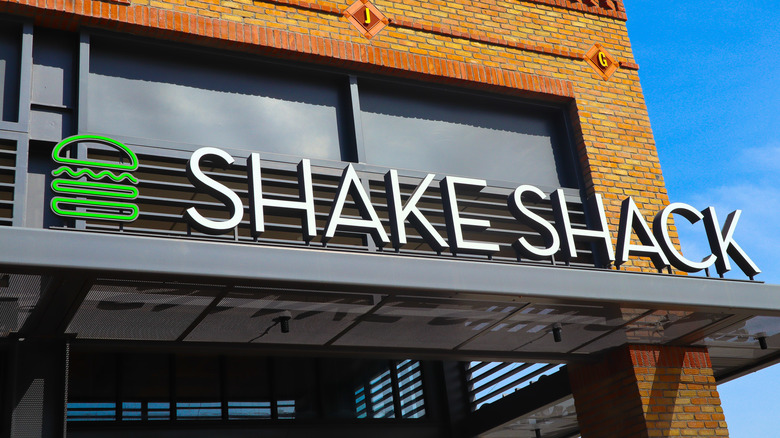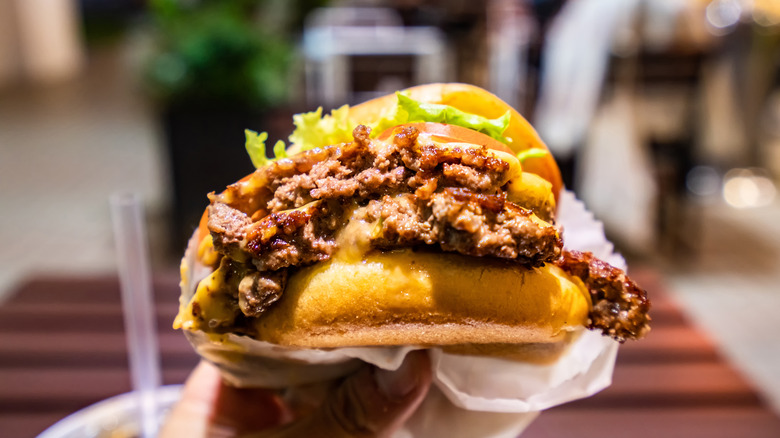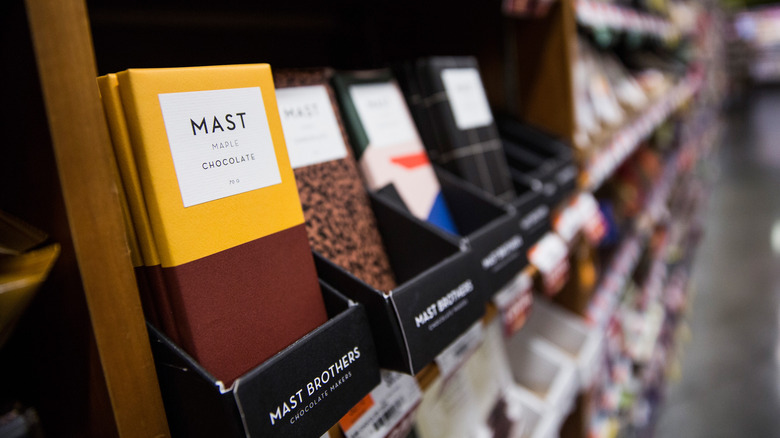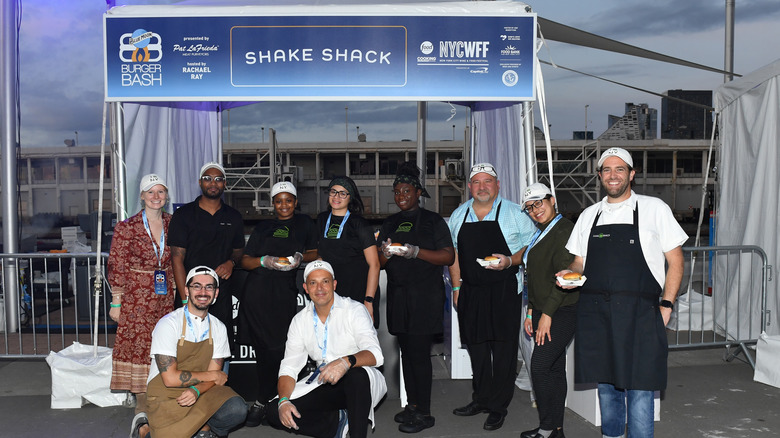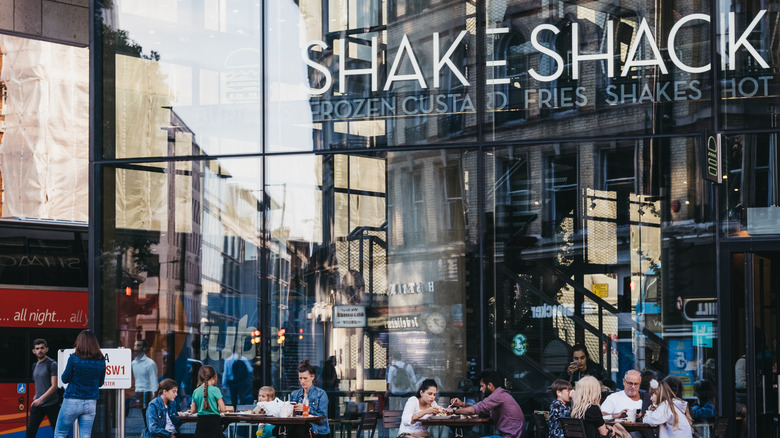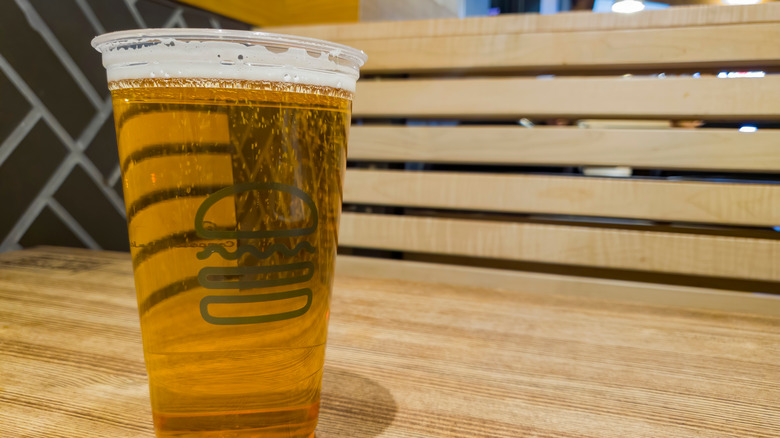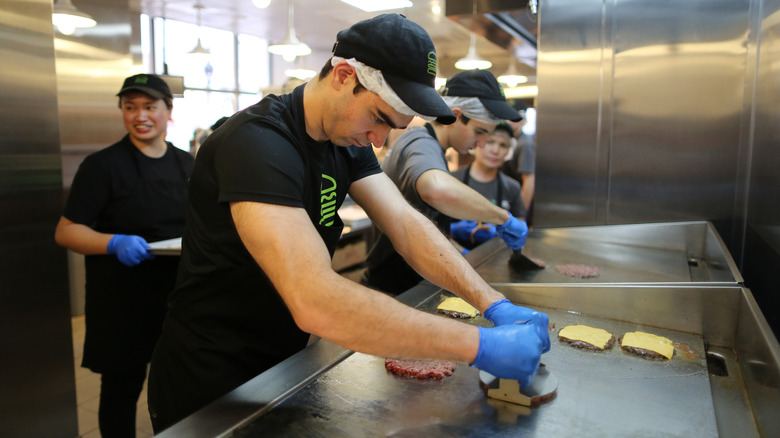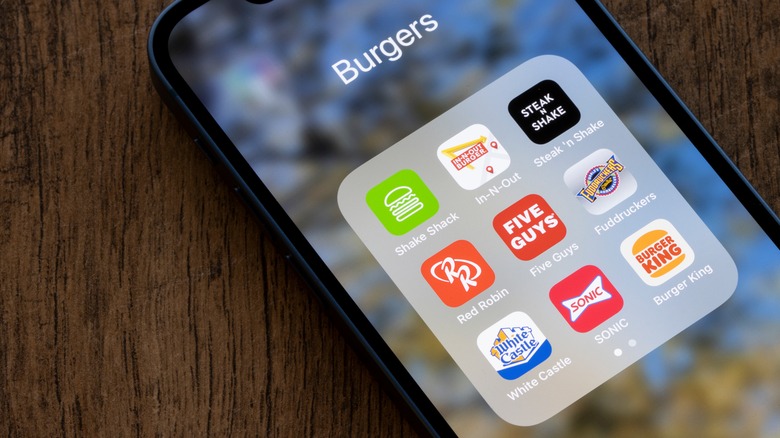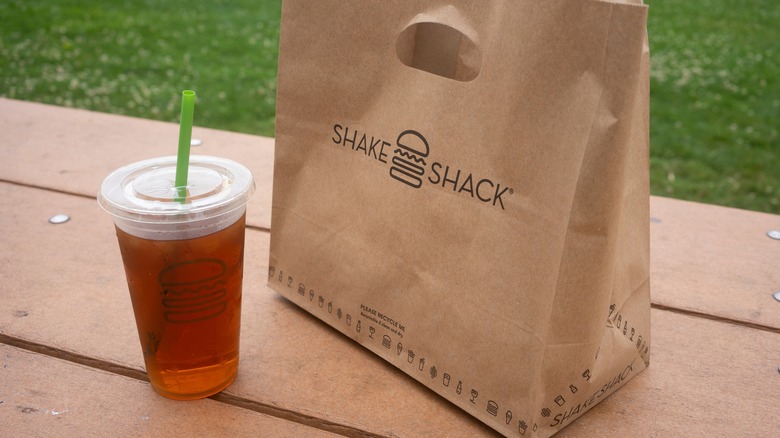The Real Reason Why Shake Shack Is So Expensive
From its humble beginnings as a hot dog cart in Madison Square Park, Shake Shack has become one of the largest small burger chains in the world. Since opening in 2001, the elevated burger spot has reached a market capitalization of more than $1.5 billion and expanded to over 300 Shacks, including more than 100 international locations across the Middle East region, London, Hong Kong, Istanbul, Philippines, Singapore, Mexico, Tokyo, Seoul, and more. It gained a cult following for its juicy burgers, crinkle-cut fries, frozen treats, and long lines — but it's also well-known for being far more expensive than your average burger chain. At any given location, prepare to pay about $15 for a Shack Burger with fries and a signature frozen custard shake.
Similar to other popular gourmet burger chains like Five Guys and Steak n' Shake who have been feeling the brunt of their bigger burger price tags, Shake Shack has also been effected with the chain's shares dipping as much as 10%. To account for this decrease in revenue, the company raised prices by 3% to 3.5% last October. Now, the already-expensive burger chain has just announced they will be topping its patties with a price raise this March, according to Chief Executive Officer Randy Garutti.
While it might seem that Shake Shack's offerings aren't very different from its competitors, there are a few key ingredients that account for why this popular burger chain's prices continue to be on the rise.
Shake Shack's concept is a combination of fine dining and fast food
Although the first Shake Shack started as nothing more than as a stand inside of Madison Square Park, once the time came to expand into a real brick and mortar location, founder Danny Meyer pulled from his background in fine-dining to come up with the burger chain's "fine-casual" dining concept. This hybrid model means that the Shake Shack experience has all the culinary qualities of a fine dining establishment, with the convenience and speed found in the traditional fast food format. Their menu is limited and priced closer to a casual dining restaurant's than a traditional fast food spot, and ingredients include things like "all-natural, hormone and antibiotic-free beef."
Part of the draw of Shake Shack's concept is that although your burger may not be served by a waiter, it's made using the same quality ingredients you'd get at a sit-down restaurant, which is why it also bears a similar price tag. The fine-casual concept has been adapted by other chains, such as Chipotle Mexican Grill and Panera Bread, which also have higher price tags for seemingly higher-quality quick cuisines.
They use a proprietary beef blend
At the core of Shake Shack's fine-casual concept is its commitment to using only fresh, high-quality ingredients in all its menu items. Shake Shack sources its ingredients from a very specific group of farmers, ranchers, bakers, and food purveyors. It took the company's research and development team a tour of seven cattle ranches in Washington State to find the right farmers for their beef on the West Coast.
For their burgers, they use a proprietary blend of vegetarian-fed, humanely raised, source-verified, antibiotic- and hormone-free beef that is ground fresh from the more expensive full-muscle cuts rather than scraps. It is widely known that Shake Shack uses a secret 80/20 blend from the famous Pat LaFrieda meat purveyors, however, they've managed to keep the exact beef breakdown on lockdown.
However, acquiring high-quality meat comes at a high cost, and recent inflation and supply chain issues have forced the cost of food, especially meat, to skyrocket. According to data from the Bureau of Labor Statistics, the price of beef increased 20.1% between October 2020 and October 2021. For Shake Shack to maintain its culinary and environmental integrity, they have to accept and increase the menu prices to reflect the prevailing market prices.
Shake Shack only uses premium ingredients
In addition to its premium meats, Shake Shack uses some of the most well-known gourmet brands to offer a modern-day take on the classic roadside burgers, fries, hot dogs, frozen custards, and shakes.
Their famous flat-top hot dogs come from Vienna Beef hot dogs, the same supplier used by Papaya King, and are topped with an artisanal relish made by Brooklyn-based Rick's Picks. They exclusively use Martin's Potato Rolls for the burgers, chicken sandwiches, and hot dog buns. All of their concretes and custards are made using 100% cage-free eggs and Nielsen-Massey pure vanilla extract, and their chocolates and toppings are provided by Mast Brothers and Guittard.
These premium products already cost a pretty penny on their own. A single Mast Brother chocolate bar runs at about $10, and Guittard Dark Chocolate Decoratifs start at $25.99 per pound. So combined with the "fine-casual" concept, the price you pay for your full Shake Shack meal is bound to be more than you'd expect from a restaurant that uses more common ingredients.
The company invests in its employees
Service plays a major part in Shake Shack's "fine-casual" experience. The company's philosophy of "enlightened hospitality" is based on the belief that by first creating a positive environment for its employees, they will in turn provide customers with a better experience. Shake Shack refers to their staff as team members and instead of hiring based on past food service experience, they look for "fun, intelligent, super friendly, high energy individuals." As a result, Shake Shack has to invest heavily in staff training to make sure all team members offer a fine-dining level of customer service.
Shake Shack employees receive a plethora of benefits that are far from most fast-food industry standards. Team members are paid on average $2 above minimum wage, and every employee (full or part-time) is eligible for health benefits and paid time off from the first day they start. Plus, they get the option for weekly pay. Employees also get a monthly bonus that's called "Shack Bucks," which is up to 1% of the company's revenue from that individual shop, and roughly adds two dollars an hour to employee pay checks. In addition, the company offers its team members paid paternal leave for both birth and adoptive parents, equity grants, financial assistance, and talent development.
While Shake Shack's policies are a game-changer in the fast-food industry, these initiatives come at a cost, and in order to account for these benefits, the company has initiated price increases. As a result, customers end up paying more to receive a better overall customer experience than they would receive at a typical burger chain.
Each location is expensive to design
The quality of Shake Shack isn't just in the food — it's reflected in each store's design as well. According to chief operating officer Randy Garutti, the company spends five times what a fast-food chain spends on its store design. Every Shake Shack location is designed using sustainable materials and has costly features such as floor-to-ceiling windows for natural lighting and a park or outdoor dining area, elements that are meant to elevate the fine-casual experience. "It's all about applying what we've learned about culinary design from fine dining to Shake Shack," Danny Meyer, Shake Shack's founder, said in an interview with the Connecticut Post.
The restaurants are also fitted with ping-pong and foosball tables, giant life-size puzzles, and local art installations to encourage customers to spend more time — and ultimately more money — at their local Shack. However, while the construction materials are sustainable, the cost of acquiring these building products can come at a premium. Recently, Shake Shack pushed back on opening new restaurants due to the soaring price of construction and materials and a lack of labor. In addition, many of these new locations will feature walk-ups or drive-thrus, which cost more to build. These costs have to be accounted for in some way, so as a result, the price you pay for a meal at Shake Shack includes the easy access and elevated atmosphere.
They offer beer and wine pairings on every menu
Keeping with its fine-casual dining concept, Shake Shack replicates the fine dining food and wine pairing experience by offering high-quality beers and wines, which have been specifically selected to complement its menu items. The happy hour-esque atmosphere encourages customers to start and spend their evening there, as opposed to being the last stop after a late night out.
These aren't just any beers and wines: The chain collaborated with Garrett Oliver of Brooklyn Brewery to create their signature ShackMeister Ale, and the house red and white wines are made exclusively for Shake Shack by Domaine Lafage. A single-serving, six-ounce pour of one of these house wines will add about $8 to $10 to your burger bill, and a bottle can cost around $30.
While a glass of beer or wine at Shake Shack is around the same price you'd pay at a local bar, when you add a burger and fries to the tab, the price you'll pay for a full meal at Shake Shack is drastically higher compared to a stop in your typical drive-thru.
The company spends quite a bit on R&D
When it comes to developing new menu items and concepts, Shake Shack takes a "quality first, price later" approach. From notoriously spending $1 million experimenting with their french fries to touring seven cattle ranches to find the right beef and building an underground food laboratory to test new recipes in real-time, the company's culinary innovation team spares no expense figuring out what works and what doesn't. When Shake Shack decides to expand to a new city, culinary director Mark Rosati will fly out the entire team to learn everything about what makes the region's culinary palette unique.
When it comes to creating a new menu item, they take as much time as needed to perfect every part of the recipe — which is why, until recently, it has taken them years to add new offerings. However, in an attempt to speed up the creative process, Shake Shack opened their Innovation Kitchen last fall, which now gives them the opportunity to test new menu items in real-time.
While spending millions testing new menu items is not foreign to the fast-food industry, for smaller chains like Shake Shack, this capital has to be accounted for somewhere — and that's typically in the price the customer pays for these new additions.
A lot of money goes into their digital tech
Recently, the burger chain has made a big investment in developing its digital hospitality technology. They have introduced digital order kiosks and launched their own delivery service via the Shack App, with menu prices below third-party providers.
In 2021, Shake Shack did a full mobile-first revamp to their website, and developed their own delivery platform in the Shack app. Through an exclusive partnership with Uber Eats, customers nationwide can now order delivery for a 99-cent fee (and free delivery on orders over $35), at menu prices below third-party delivery. They have also expanded their e-commerce capabilities by joining Goldbelly's nationwide site to deliver their proprietary burgers to customers across the country via mail.
However, this convenience comes at a cost, and while it may seem like the price you pay to have Shake Shack delivered to your door is less than DoorDash or Grubhub, the final price is still higher than other burger delivery options, especially since they recently announced price increases to their digital orders.
Shake Shack takes sustainability very seriously
One of Shake Shack's core values is a commitment to reducing its environmental impact. In addition to using sustainable and upcycled furniture in its stores, sourcing ecologically-friendly beef for their burgers, and donating to global clean water initiatives, they were one of the first large chains in the fast-food industry to make the change to using eco-friendly utensils and straws. The company partnered with Restore Foodware to introduce biodegradable AirCarbon straws and cutlery in their West Hollywood, Long Beach, Madison Square Park, West Village, and Miami Beach locations, and has since pulled all plastic from their restaurants nationwide. In addition, they have also switched to using reusable to-go packaging and aluminum SHACK20 water bottles on the West Coast.
According to Restore Foodware's website, a set of their premium reusable cutlery costs $4.99, but even at wholesale prices, these forks and knives are a slice above less conscious silverware. While these ecological upgrades go far when it comes to saving the environment, the cost of offsetting their carbon footprint is often reflected in the overall price the customer pays at the checkout.
